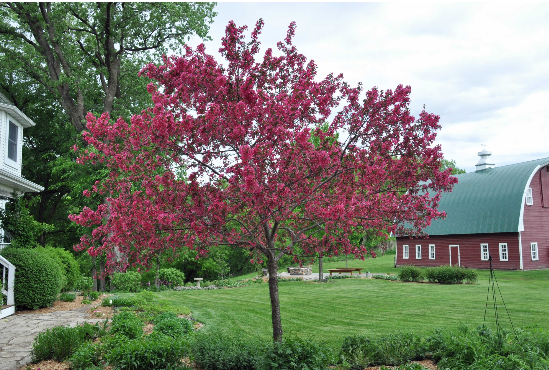
Prairifire’ crabapple trees (Malus x ‘Prairifire’) also referred to as Iowa crab is a species of crabapple tree ( genus Malus), which includes about 35 species native to Eurasia and North America. Prairifire Crabapple grows to a height of 15-20 feet. It is usually adorned with reddish new foliage that matures to a dark green, complemented by lovely deep pink spring flowers that produce persistent, small, dark red-purple fruits. Hungry birds usually feast on its berry-sized, purple-red fruit that lasts into winter. This tree is hardy in USDA Zones 4-8. ‘Prairifire’ makes a striking accent plant or espalier. Planted in colonnades along walks and driveways, it leaves an indelible impression.
The highlights of the Prairifire Crabapple is usually its spring bloom. The tree is adorned with masses of slightly fragrant, dark pink to red flowers, which bloom in mid-late spring. These flowers are followed by abundant purplish-red crabapples that mature in the fall and persist well into winter’
Characteristics of Prairifire Crabapple Trees
- Has an upright form in youth, maturing to a rounded crown with age.
- Can live for up to 50 years with proper care and maintenance.
- Hardy in USDA zones 4 to 8.
- Moderate growth rate, reaching maturity within 10 to 20 years (12-18 inches per year).
- The tree’s leaves emerge in a purplish color in the spring. As the season progresses, these leaves mature into a dark green color with reddish-tinged veins and petioles.
- Usually has deep pink to red flowers in spring. These flowers emerge from pinkish-red buds and appear in masses. Flowers emerge before the leaves.
- Abundant, small (½ inch) dark red-purple crabapples mature in fall and persist into winter.
- Excellent resistance to common crabapple diseases (apple scab, cedar-apple rust, fire blight, mildew)
- Attracts pollinators in spring and provides a food source for birds in fall and winter.
- Adapts to a wide range of soils but thrives in well-drained, moderately fertile loams with slightly acidic pH.
- The tree is primarily ornamental, also a food source for birds and wildlife (not typically eaten by humans).
- Suitable as a specimen tree in residential gardens, parks, and urban landscapes.
- Relatively low-maintenance once established.
- Suitable as an ornamental specimen or in masses, and under utility lines due to its rounded crown.
Growing Prairifire Crabapple Trees in the Landscape
Planting
- Timing: Plant your Prairifire crabapple in early spring or fall when the weather is cooler.
- Location: Choose a spot with full sun for at least 6 hours a day. It tolerates some light shade, but flowering and fruit production may be reduced.
- Soil: While adaptable, the Prairifire crabapple prefers well-drained, moderately fertile loams with slightly acidic pH (6.0-7.0). Amend clay soil with sand or compost to improve drainage.
- Planting Process: Dig a hole 2-3 times wider than the root ball and slightly deeper. Gently loosen the root ball and position the tree so the root flare (base of the trunk) sits slightly above the surrounding soil level. Backfill the hole with soil, tamping gently to remove air pockets. Water thoroughly to settle the soil.
Watering
- Young Trees: Water regularly, especially during the first year and during hot, dry periods. Aim to keep the soil consistently moist but not soggy.
- Established Trees: Once established (usually after 2-3 years), Prairifire crabapples are drought tolerant and require infrequent watering. However, during extended dry spells, a deep watering every week or two might be beneficial. Watch for signs of thirst like wilting leaves or dry soil.
Fertilizing
- Young Trees: In early spring, fertilize young trees with a balanced fertilizer according to package directions. This helps establish strong roots and encourage healthy growth.
- Established Trees: Mature Prairifire crabapples may not require additional fertilization, especially if the soil is already fertile. Signs of nutrient deficiency include pale leaves or stunted growth. In such cases, a light application of fertilizer in early spring might be helpful.
Pruning
- Timing: Prune your Prairifire crabapple tree in late winter while it’s dormant. This minimizes the risk of disease and allows you to see the branch structure clearly.
- Purpose: The main focus of pruning is to remove dead, diseased, or overcrowded branches. This improves air circulation within the canopy, promotes healthy growth, and helps maintain the desired shape.
Additional Care
- Mulching: Apply a 2-3 inch layer of mulch around the base of the tree. Mulch helps retain moisture in the soil, suppresses weeds, and regulates soil temperature. Renew the mulch layer every few years as it decomposes.
- Fall Leaves: You can leave fallen leaves under the tree to decompose naturally. This provides nutrients for the soil and helps create a habitat for beneficial insects.
Considerations
- Fruit Drop: The abundant fruit production can lead to fallen fruit, which can stain light-colored surfaces. Consider planting it away from patios or walkways.
- Toxicity: Be aware that all parts of the Prairifire crabapple tree are considered toxic to pets and horses.